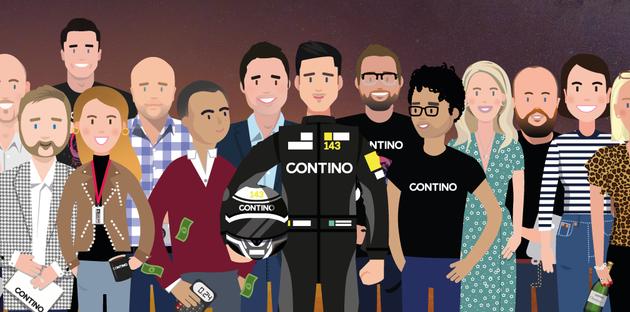9 Game-Changing DevOps and Cloud Trends [2020]
What will the most techie-tickling trends be in 2020 from the world of DevOps and cloud?
We asked our brainiac engineers what trends they expect will make them and/or their customers squeal with nerdy anticipation!
Here are their top 9 responses!
- Kubernetes and Serverless Move to Day Two Operations
- SRE Becomes Necessary Or Your Cloud Will Not Scale Beyond a Certain Critical Point
- FinOps Teams Will Save Many Cloud Programs From Extinction
- Machine Learning Starts Delivering on Hype with Augmented Products
- Serverless Driven By the Business (Not IT) to Enable Brand-New Business Models
- Cognitive CX Brings Seamless Omnichannel Capability Within the Reach of Most Companies
- Security Teams Left Even Further Behind By Cloud-Native Growth Curve
- GitOps Overtakes Traditional CI/CD
- ‘Ambidextrous’ Innovation Becomes the Hallmark of Companies That Succeed
So let’s get right into the details!
Top Cloud and DevOps Trends 2020
#1 Kubernetes and Serverless Move to Day Two Operations
With maturity rising, it’s now all about delivering business outcomes, not just infrastructure!
Part 1: Kubernetes. No Longer a Pain, Companies Can Focus on Value-Add Functionality
Until recently, even installing Kubernetes was a pain. You needed expert knowledge, only a few of the installers worked and only GCP had a half-decent managed service.
Most organisations had their hands full just getting a cluster up and running.
But now there are hundreds of offerings from vendors, many ways to run it locally and all three major cloud providers have a managed service.
In 2020, the focus will shift from ‘day one operations’ (installing/configuration) to ‘day two operations’: the outcome-focused stuff.
That means: monitoring, logging, disaster recovery, GitOps, serverless etc., as well as creating ops dashboards, creating proper processes in your teams, learning how to debug issues and so on.
The game is no longer about managing infrastructure but on operationalising Kubernetes for business value: focusing on the app/developer experience instead of on setting up the behemoth!
Part 2: No Longer ‘Fancy’, Serverless Becomes Part of the New Standard
Serverless is as old as Kubernetes (five years or so), but the frameworks are very mature. AWS Lambda, for example, has a lot of functionality and (as we will see below) serverless services are eating up more and more of the tech stack.
The serverless approach has been proven beyond doubt in major organisations and massive enterprises. And a lot of the old myths have been resolved: cold-boot startups, tooling problems, debugging issues.
The tools are there. The stories are there. It’s no longer ‘cool’ or ‘edgy’. In 2020, serverless will be a default approach for developing software.
#2 Your Cloud Will Not Scale Beyond a Certain Point Unless You Adopt SRE
SRE takes a data-driven approach to cloud operations. You look at key metrics to determine the state of your system and use that data to decide whether you should stop building new features and focus on ensuring the reliability of the platform.
It’s about balancing reliability and development.
To date, organisations have always focused on feature first, reliability later.
But, as your cloud program scales, unless you start baking reliability principles and reliability-based feature stories into cloud platforms you will always reach a tipping point beyond which you cannot scale.
Creating Antifragile Systems: Site Reliability Engineering for the Enterprise
Enterprises need to be thinking less like a business-business and more like a tech-business.
Enter Site Reliability Engineering or SRE.
SRE is a data-driven approach to IT that ensures that even wildly complex distributed IT systems are healthy. It can help you to turn fragile enterprise systems into antifragile ones that get better the more they are shocked! Download this white paper to discover everything you need to know about creating antifragile systems using SRE!
In 2020, companies that don’t take an SRE-like approach will always have fragile systems. Only individual teams will know why a service was designed a certain way, how it was built, or how it is run.
SRE brings the entire feedback loop together so your team can scale the cloud safely!
#3 FinOps Teams Will Save Many Cloud Programs From Extinction
Cloud finance is a tightrope walk.
Engineers often don’t appreciate the financial burden they represent to the company. At the same time, finance teams aren’t cloud-savvy enough to figure out how they can rein in spiralling cloud costs.
In the worst case, this can cause exasperated directors to doubt the benefits of the cloud and pull the plug.
But the problem is not the cloud; it’s your cloud consumption model!
Enter FinOps.
FinOps breaks down the siloes between finance, procurement and engineering. This cross-functional collaboration can establish policies and controls (and the transparency required to make them a reality) to safeguard cloud consumption.
The benefits? It prevents spurious cloud consumption patterns and optimizes cloud consumption. Ultimately, it could save a cloud program that otherwise would have been mired by spiralling costs.
Why is it so important in 2020?
Cloud spend is predicted to grow massively. This implies a big shift in IT spend from CapEx to OpEx as hardware expenditure gets diverted into cloud operations.
In this new world of cloud, finance teams are not always sure how to handle costs, which can spiral as a result and eat into the ROI of your cloud program.
Finance need to understand cloud consumption models. Engineering need to provide visibility so finance can self-serve all the information to map out cloud costs. Procurement will need to grasp the cloud marketplace and change the rhythm of their software procurement to match the cloud’s flexibility.
In 2020, the FinOps Team will be the MVPs of next-generation cloud migration, saving many cloud programs from potential extinction!
#4 Machine Learning Starts Delivering Business Value as the Cloud Makes It Accessible
At AWS re:Invent 2019, Machine Learning was the most popular category in terms of number of services announced. 20 of all 77 announcements were in the ML category (the only other category to hit double digits was ‘compute’ at 16).
All of the announcements from re:Invent are about ML ‘as-a-service’ or integrated into products so it’s much more accessible than ever before. This includes the first ML services for specific sectors, with Fraud Detector and Transcribe Medical. The huge Robotic Process Automation (RPA) market is also a leading indicator of popularity.
The case for using ML to augment products directly is now taken for granted in the best-performing organisations. Check out our recent panel discussion with DLG (and/or see #9 below!) for an example of how to use ML to create a new, break-away insurance product.
In 2020, if ML isn’t a part of your product development then you need to take steps to make it so. Others will certainly be doing so!
#5 Serverless Driven By the Business (Not IT) to Enable Brand-New Business Models
From 2017 to 2018 serverless saw a 75% growth rate.
The serverless trend shows no sign of slowing down. With automated scalability, capacity planning and cost management, you can build software that’s easier to build, maintain and often up to 99% cheaper.
But this isn’t new.
What is new is the growing realisation that serverless is much, much more than just a new form of compute.
Going serverless is the highest level of abstraction possible. Whoever is using it will only be writing business logic. As Werner Vogels said in 2019: you should only ever write business logic!
This incredible capacity for disruption is being used to drive business transformation and enable innovative business models.
In 2020, serverless will resonate most with board members and C-levels who—more so than those in IT—see the potential of serverless to break out of the strait-jacket of legacy and provide novel solutions to otherwise intractable business challenges.
And the spectrum of IT services that serverless encompasses will continue to expand: it used to be just functions, but is now available for databases and will move further into machine learning and artificial intelligence.
#6 Cognitive CX Brings Seamless Omnichannel Experience Within the Reach of Most Companies
Emerging technology around virtualised contact centres (e.g. Amazon Connect), plus value-add services for existing contact centres (e.g. Google Contact Center AI) is transforming the customer experience.
This has been dubbed ‘Cognitive CX’: using customer data and technology to create intelligent, relevant customer experiences.
In 2020, new cloud services now bring this within the reach of any company that wants to build that experience.
This includes seamlessly combining voice and chat, sentiment analysis, chatbots, transcribing conversations to text (as well as storing and analysing it), real-time recommendations for next-best-action for call centre staff, real-time translations and so on.
You could use Amazon Personalize to help understand what the customer’s needs are, Amazon Transcribe for speech-to-text transcription (allowing further analysis and logging), and Amazon Lex for chatbot automation to reply to the customer automatically.
Imagine how long it would take your average enterprise to build that level of AI technology in-house! It would not be possible. Now they can consume it on-demand and as-a-service!
#7 Cloud-Native Growth Curve Leaves Security Teams Even Further Behind
The OWASP list of the top 10 security issues hasn’t changed much over the last few years.
At the same time, the context for security (i.e. the platforms that have become the new default) has shifted drastically: there has been a cloud native revolution!
So the issues are the same, but how you find them and secure them has changed.
And security teams have yet to figure out how to effectively port ‘old-world’ security into this new world. So the new generation of security folk are repeating the same mistakes and errors from before, e.g. networking being too open, code vulnerabilities, etc.
In 2020, security teams will be left even further behind as cloud-native adoption accelerates.
The practices for dealing with these have either been ignored (because the security teams have no visibility of the new platforms) or the skills just aren’t there (it’s hard enough to hire DevOps engineers; DevSecOps experts are ten times rarer still!).
For example, at Contino we see many enterprises attempt to pen test Kubernetes. But they’re using legacy tooling that can barely scratch the surface of the new apps! And although the market is growing for cloud-native security tools, these are expensive and its difficult to find the talent to deploy them effectively.
#8 GitOps Overtakes Traditional CI/CD
GitOps is a cloud-native approach to delivering applications that is centred around Kubernetes.
In 2020, GitOps will transform change management, overtaking CI/CD as the way to deploy at speed.
The central principle is that Git(Hub) becomes the focal point of your pipeline. It is the single source of truth and the only place where changes are made. You push your code to Git and your Kubernetes cluster will constantly sync up with the latest code.
What this means is that changes can be deployed continuously with no gates at any point. This means that there is no CI/CD anymore, which completely changes how teams operate. With GitOps, you essentially have an automated operating model for Kubernetes, resulting in much faster changes with greater stability.
Many people in the Kubernetes community are moving in that direction (the most popular Git project is a GitOps tool!) and more and more people putting workloads on Kubernetes will be using GitOps rather than traditional CI/CD.
As Kubernetes’ meteoric rise continues, it will take GitOps with it!
#9 ‘Ambidextrous’ Innovation Becomes the Hallmark of Thriving Companies
More and more companies are making the move to the cloud, taking advantage of elasticity, cost efficiency and agility.
But the question remains: are companies truly innovating once they are in the cloud?
The cloud is a platform: a means to an end. It can help a company to go faster, but in which direction?
The truth is that innovation takes two forms:
- Exploiting existing product offerings (new features etc.)
- Exploring new alternatives (net-new products and services)
Ambidextrous innovation is finding the perfect balance between exploiting and exploring; disrupting and sustaining.
They can survive by improving (incrementally) their existing products but must in parallel explore new disruptive offerings while not disrupting the core that they are exploiting.
In 2020, we will see a new recipe for business success in the digital era: while incrementally transforming, enterprises create born-in-the-cloud ‘startups’ as side-projects.
These are designed to incubate digital innovation and develop new products/offerings/insights back to the wider business.
Take, for example, Direct Line Group. They worked with Contino to set up a start-up insurance brand called Darwin in 2019, described by CFO Penny James as being designed to “use different pricing techniques based on machine learning”.
(Check out the full story as told at the AWS Financial Services Symposium!).
At the core of the story is an ‘oil tanker and speedboat’ analogy, designed to illustrate how the Darwin initiative helps Direct Line Group to reconcile the company’s need to be agile like a start-up while simultaneously taking advantage of the scale offered by the enterprise organisation.
DLG is innovating both incrementally within their core business, while using cloud-native technology to break away from legacy and rapidly incubate new offerings.
That’s the recipe for success in the digital era!
That’s it for our top trends for 2020!
If you'd like to hear more about how to use these trends to your advantage, tune into our upcoming webinar!
![9 Game-Changing DevOps and Cloud Trends [2020]](https://cdn.sanity.io/images/hgftikht/production/0eb3e8126ec5f7ec8892bf09e7c36b937aa06f3c-1200x511.png)





